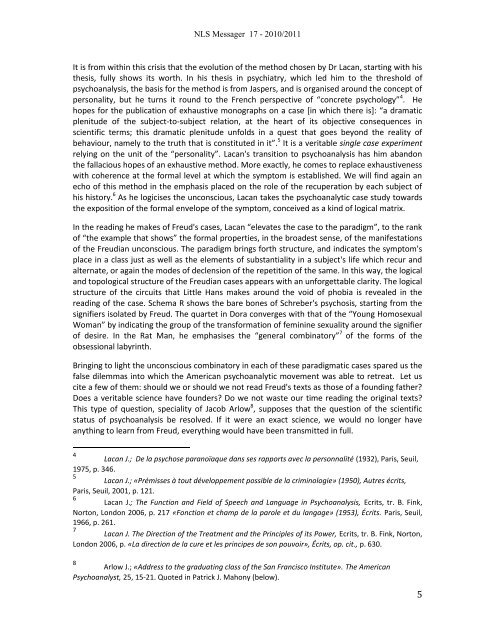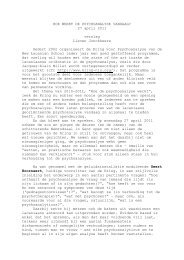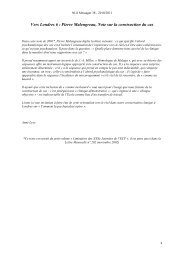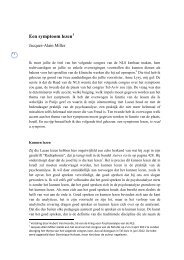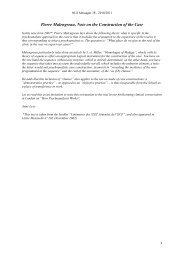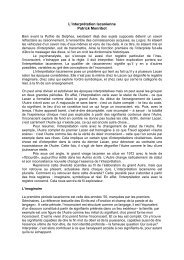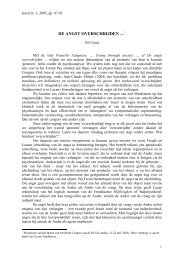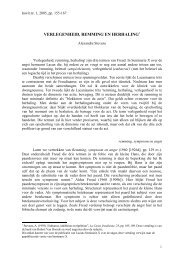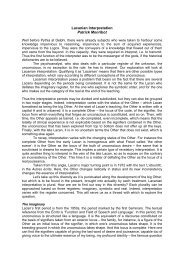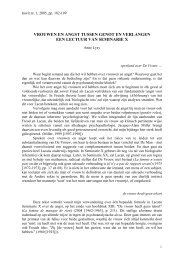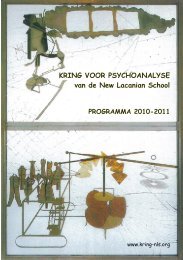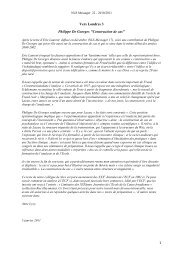Vers Londres 2 Eric Laurent, « Le cas, du - Psychoanalyse Lacan ...
Vers Londres 2 Eric Laurent, « Le cas, du - Psychoanalyse Lacan ...
Vers Londres 2 Eric Laurent, « Le cas, du - Psychoanalyse Lacan ...
Create successful ePaper yourself
Turn your PDF publications into a flip-book with our unique Google optimized e-Paper software.
NLS Messager 17 - 2010/2011<br />
It is from within this crisis that the evolution of the method chosen by Dr <strong>Lacan</strong>, starting with his<br />
thesis, fully shows its worth. In his thesis in psychiatry, which led him to the threshold of<br />
psychoanalysis, the basis for the method is from Jaspers, and is organised around the concept of<br />
personality, but he turns it round to the French perspective of “concrete psychology” 4 . He<br />
hopes for the publication of exhaustive monographs on a <strong>cas</strong>e *in which there is+: “a dramatic<br />
plenitude of the subject-to-subject relation, at the heart of its objective consequences in<br />
scientific terms; this dramatic plenitude unfolds in a quest that goes beyond the reality of<br />
behaviour, namely to the truth that is constituted in it”. 5 It is a veritable single <strong>cas</strong>e experiment<br />
relying on the unit of the “personality”. <strong>Lacan</strong>'s transition to psychoanalysis has him abandon<br />
the fallacious hopes of an exhaustive method. More exactly, he comes to replace exhaustiveness<br />
with coherence at the formal level at which the symptom is established. We will find again an<br />
echo of this method in the emphasis placed on the role of the recuperation by each subject of<br />
his history. 6 As he logicises the unconscious, <strong>Lacan</strong> takes the psychoanalytic <strong>cas</strong>e study towards<br />
the exposition of the formal envelope of the symptom, conceived as a kind of logical matrix.<br />
In the reading he makes of Freud's <strong>cas</strong>es, <strong>Lacan</strong> “elevates the <strong>cas</strong>e to the paradigm”, to the rank<br />
of “the example that shows” the formal properties, in the broadest sense, of the manifestations<br />
of the Freudian unconscious. The paradigm brings forth structure, and indicates the symptom's<br />
place in a class just as well as the elements of substantiality in a subject's life which recur and<br />
alternate, or again the modes of declension of the repetition of the same. In this way, the logical<br />
and topological structure of the Freudian <strong>cas</strong>es appears with an unforgettable clarity. The logical<br />
structure of the circuits that Little Hans makes around the void of phobia is revealed in the<br />
reading of the <strong>cas</strong>e. Schema R shows the bare bones of Schreber's psychosis, starting from the<br />
signifiers isolated by Freud. The quartet in Dora converges with that of the “Young Homosexual<br />
Woman” by indicating the group of the transformation of feminine sexuality around the signifier<br />
of desire. In the Rat Man, he emphasises the “general combinatory” 7 of the forms of the<br />
obsessional labyrinth.<br />
Bringing to light the unconscious combinatory in each of these paradigmatic <strong>cas</strong>es spared us the<br />
false dilemmas into which the American psychoanalytic movement was able to retreat. <strong>Le</strong>t us<br />
cite a few of them: should we or should we not read Freud's texts as those of a founding father?<br />
Does a veritable science have founders? Do we not waste our time reading the original texts?<br />
This type of question, speciality of Jacob Arlow 8 , supposes that the question of the scientific<br />
status of psychoanalysis be resolved. If it were an exact science, we would no longer have<br />
anything to learn from Freud, everything would have been transmitted in full.<br />
4<br />
<strong>Lacan</strong> J.; De la psychose paranoïaque dans ses rapports avec la personnalité (1932), Paris, Seuil,<br />
1975, p. 346.<br />
5<br />
<strong>Lacan</strong> J.; «Prémisses à tout développement possible de la criminologie» (1950), Autres écrits,<br />
Paris, Seuil, 2001, p. 121.<br />
6<br />
<strong>Lacan</strong> J.; The Function and Field of Speech and Language in Psychoanalysis, Ecrits, tr. B. Fink,<br />
Norton, London 2006, p. 217 «Fonction et champ de la parole et <strong>du</strong> langage» (1953), Écrits. Paris, Seuil,<br />
1966, p. 261.<br />
7<br />
<strong>Lacan</strong> J. The Direction of the Treatment and the Principles of its Power, Ecrits, tr. B. Fink, Norton,<br />
London 2006, p. «La direction de la cure et les principes de son pouvoir», Écrits, op. cit., p. 630.<br />
8<br />
Arlow J.; «Address to the gra<strong>du</strong>ating class of the San Francisco Institute». The American<br />
Psychoanalyst, 25, 15-21. Quoted in Patrick J. Mahony (below).<br />
5


